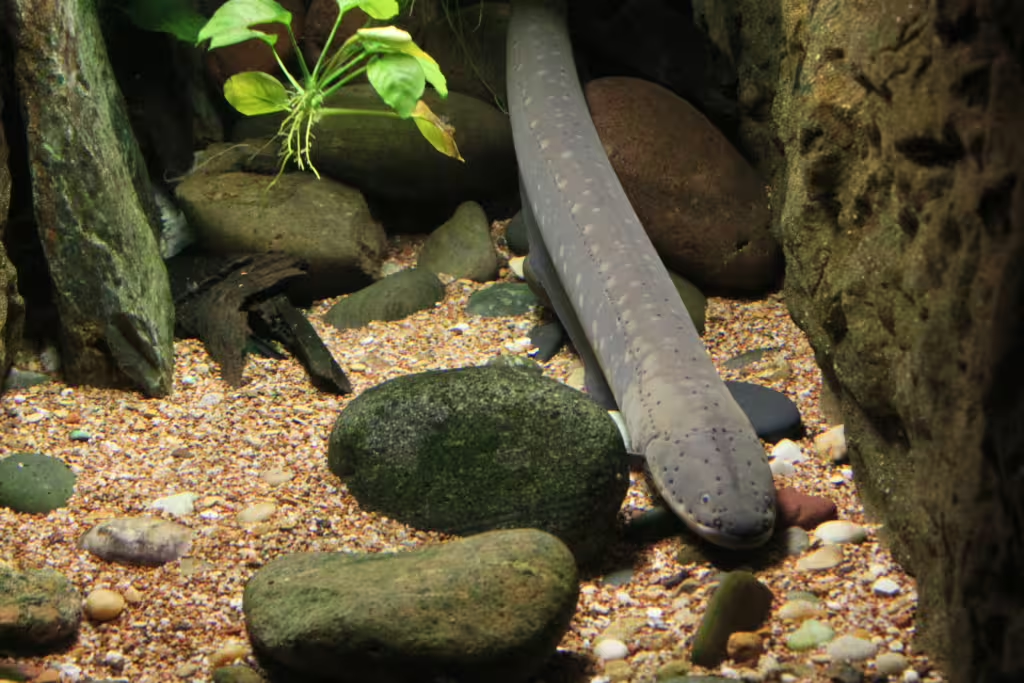One of the most fascinating creatures in the seven…well actually, let’s start over. Shocking as it might seem, electric eels are one of the many eel species that spends a good majority of their time, all of it, in fact, in freshwater rivers. These electrifying fish are possessed of one of nature’s most fascinating adaptations; they can generate electricity in their own bodies. So much electricity, that they have the potential to kill a person. It’s only been rare cases, mind you, but the amount of voltage contained in the body of an electric eel could well be categorized as deadly.
Fortunately for the avid river swimmers out there, electric eels can only be found in the murky waters of South America’s Amazon and Orinoco River basins. These remarkable fish, and yes, they are indeed fish, have captivated scientists and nature enthusiasts for centuries. In this article, we will discuss the shocking abilities of the legendary electric eel, but we will also talk about the other adaptations they possess. We will touch on the lives they lead, the environment they live in, and how they fit into the vast interconnectedness of aquatic ecosystems. We will also touch on a few other eel species, to see how they compare to this most famous of fishes.
The Anatomy of Electricity: How Electric Eels Generate Power
Electric eels, known by the scientific name Electrophorus spp, are equipped with specialized organs that allow them to produce electric discharges of up to 600 volts of electricity. These organs, which make up most of their elongated bodies, work in this way because they are packed with electrocytes, no, not electrolytes, those are in coconut water. These specialized muscle cells have been modified by evolution so that the eel can store and release electrical charges.
The Three Electric Organs
Main Organ: This organ produces high-voltage shocks used for hunting and self-defense.
Hunter’s Organ: This organ assists in generating low-voltage signals for navigation and communication.
Sachs Organ: Finally, the sachs organ produces low-voltage discharges to detect the environment.
When an electric eel releases a shock, the electrocytes within its muscle tissue discharge simultaneously, creating a powerful electric field around the animal itself. This electric burst can be used to stun prey or deter predators in equal measure. As far as natural survival tools go, we would have to say this one rivals even Pikachu’s, and it’s highly effective in this regard.
Life in the Murky Waters: Electric Eel Behavior and Habitat
Electric eels are river dwelling fish, but not true eels as their shape would have you believe. These eels thrive in slow-moving freshwater rivers, streams, and flooded forests, though such habitats are often oxygen-poor. As a result, electric eels are often required to surface regularly in order to breathe air. You heard correctly; electric eels are indeed capable of breathing air. They are considered obligate air breathers, which means they are obligated to breathe air only when they need to surface to do so. So, some of the time.
As far as hunting behavior is concerned, electric eels tend to be pretty solitary. When you can shock every living thing in the surrounding, liquid area, it tends to be a good idea to keep of the way of your electrifying kinsmen. Remarkably, electric eels can use their electric capabilities to locate prey as well. They do this by using electrolocation, which enables them to sense their surroundings and potential prey by sensing the electric impulses in the bodies of their desired snacks. Some scientists have likened this ability tot he way bats use echolocation. And obviously, their ability to discharge their electricity allows them to immobilize and consume prey like fish, amphibians, and small invertebrates.
During the breeding season, male electric eels build foam nests where females lay their eggs. When the deed is done, the male guards the nest and the ensuing offspring from predators until they are ready to survive on their own.
Other Eel Species: A Diverse World
While electric eels are the most famous of the so-called “eels” as far as the status quo is concerned, the world is home to a variety of true eels and eel-like fish. Each of the electric eels, elongated brethren comes with its own fascinating adaptations.
Moray Eels
Found in tropical and subtropical oceans, moray eels are another fairly recognizable fish known for their vibrant colors and very sharp teeth. These predatory eels live in coral reefs and rocky crevices, ambushing prey such as fish and crustaceans when they poke their toothsome heads out of their hidey holes. Morays posses a double-jawed mechanism in their mouth that allows them to grasp and pull prey into their throats with little effort, making them formidable hunters.
European Eel
The European eel (Anguilla anguilla) has a highly-unique life cycle that takes it across the entire world during its lifetime. It migrates from freshwater rivers in Europe all the way to the Sargasso Sea for spawning. For many years, people didn’t even know how these eels bred, believing that the eels in the rivers, the eels in the Sargasso, were two different species. Sadly, this once plentiful species has faced significant decline in the modern age due to habitat loss, overfishing, and barriers like dams that block crucial migration routes. Fortunately, several conservation efforts are in place to restore populations of this critically endangered species.
Conger Eels
Conger eels are another of the large, predatory saltwater eels of the world. These eels typically inhabit coastal areas and are nocturnal hunters. Feeding on fish, squid, and crustaceans, congers are most well-known for their immense size, with some species growing over 10 feet long.
American Eel
The American eel (Anguilla rostrata) shares similarities with its European counterpart, in that it too migrates from its river home to the Sargasso Sea in order to spawn. It is important to note that this species plays an important ecological role as both predator and prey in both freshwater and estuarine ecosystems.
Garden Eels
Garden eels are smaller and more slender than many of the other eels on this list. These eels are one of the least solitary of the bunch, living in colonies, which are anchored in sandy burrows on the ocean floor. You’ve probably seen videos of them, swaying to and fro in the current in order to feed on plankton. They sort of resemble underwater grass in that way, making them a unique sight to behold within coral reef ecosystems.
Snake Eels
Snake eels are avid burrowers that love to inhabit sandy and muddy ocean floors. Unlike other eels, these eels are so snakelike in. their appearance that they are often mistaken for actual sea snakes. Like so many of the animals we discuss on this page, the snake eel is in danger. Mainly because the habitat they inhabit is critical to maintaining sediment health in marine ecosystems.
Animals with Galvanic Adaptations
Electric eels aren’t the only creatures that have developed the amazing ability to generate or detect electricity. Across diverse habitats, numerous species have evolved this remarkable trait. Whether they utilize this ability for hunting, communication, navigation, self-defense, or some combination of all of them, each of them brings something unique to the planet. Each of the species discussed below utilizes electricity in ways uniquely suited to its environment, showcasing the unbridled ingenuity of evolution.
Electric Rays
Electric rays, members of the Torpedinidae family, are among the more well-known creatures capable of producing electricity. These rays can be found in oceans all over the world, inhabiting sandy and muddy seafloors. Electric raya prey on small fish and crustaceans and possess two large, kidney-shaped electric organs that they use for this purpose. Located near their heads, these organs can generate powerful electric shocks ranging from 8 to 220 volts, depending on the species in question.
The primary functions of these electric shocks are for predation and defense, same as in the electric eel. When hunting, an electric ray will stun its prey, rendering it immobile and much easier to capture and devour. When used for defense, the electric shock can deter predators, such as sharks and larger fish. Interestingly, electric rays have been observed utilizing their electric fields not for electrolocation, helping them navigate their environment and detect prey hidden beneath the substrate.
Electric Catfish
Shocking though it may be, some catfish have electricity as well. Known only as electric catfish, these amazing creatures can generate low-voltage electric shocks of up to 450 volts, making them effective hunters and defenders. Electric catfish dwell in the freshwater systems of Africa, just like their electric eel cousins in South America. Unlike electric eels, however, the catfish do not rely on high-voltage discharges for stunning prey; instead, they use their electricity to subdue smaller fish and invertebrates in close proximity.
Electric catfish are nocturnal hunters, similar to electric eels, allowing them to take full advantage of their electric organs as they locate prey in the dark, murky waters of their habitat. Their ability to produce electricity also serves as a powerful deterrent against predators.
Stargazers
Stargazers are so-named for their distinctive, upward-facing eyes. Make no mistake, these fish are e bottom-dwellers and can be found swimming around in coastal waters around the globe. Their electric organs are in their head and they use those shocking abilities for defense and predation, same as the rest. Though the electric shocks they produce are weaker than those of electric rays or eels, they are still effective enough to deter most potential threats.
Stargazers also happen to be better ambush predators than most of their electric bedfellows, burying themselves in sand or mud with only their eyes and mouth exposed. When prey swims nearby, they strike rapidly, delivering a brief but powerful shock to immobilize the new morsel. In addition to their electric capabilities, stargazers have also evolved venomous spines for defense, making them one of the few marine species with both venom and electricity as defensive tools.
Elephantfish
The elephantfish is an unusual animal, typically found in Africa’s freshwater rivers and streams. Elephantfish possess a more subtle form of electrical ability than the other animals on this list. Unlike the high-voltage shocks produced by electric eels or rays, elephantfish generate weak electric fields that they use to navigate and communicate in their dark and murky environments.
Unlike aggressive electrifiers, elephantfish use specialized electric organs to emit low-voltage pulses, which interact with objects and other fish in their surroundings. By interpreting the feedback from these pulses, elephantfish can effectively map their environment, locate prey, and even communicate with other members of their species, even in conditions of low visibility.
Electric Fish and Evolution
The ability to generate or sense electricity seems like it is common enough, based on the animals you read about above. The interesting thing is, this amazing ability evolved independently in various species, which means that is has a highly-important, though very specialized evolutionary advantage. In murky aquatic environments where vision is limited, electricity provides an alternative way for fish and other aquatic animals, like the platypus, to interact with their world.
From high-voltage shocks for predation and defense to low-voltage fields for navigation and communication, electric animals frequently demonstrate an adaptability and ingenuity that can be found in few other places in the animal kingdom.
In addition to their ecological significance, most of these amazing creatures play a vital role in scientific research. Understanding how animals generate and use electricity has been a boon to our understanding of life itself and inspired advancements in technology, from medical devices to bioengineering solutions.
Threats to Electric Eels and Other Aquatic Species
Like many other aquatic species, electric eels face threats from habitat destruction, pollution, and climate change. Most of these problems are caused by humans, which is unsurprising given how we tend to treat our environment. The rampant deforestation in the Amazon basin has been particularly devastating and has reduced the availability of suitable habitats, while water pollution from mining and agriculture degrades water quality.
True Investigator Says…
As you can see, electric eels are not just a household name or a killing tool for Bond-style supervillains, they are a testament to the wonders of evolution. The electric adaptations of these and other animal showcase how creatures learn to adapt to their environments in extraordinary ways. Protecting these species and their habitats is not just crucial for preserving biodiversity and maintaining the health of the world’s waters, it is absolutely imperative so that we can continue to further our understanding of some of life’s greatest mysteries.
Discover more from TrueInvestigator
Subscribe to get the latest posts sent to your email.


